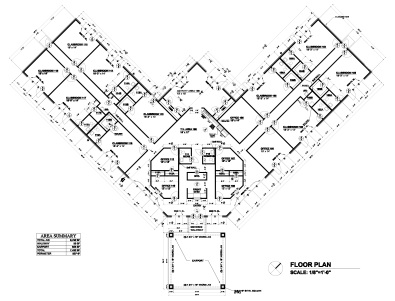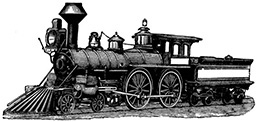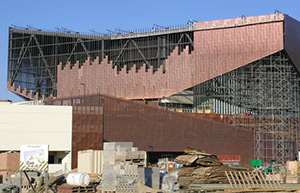The Structure of an Essay
by Owen Fourie
The structure of an essay should always be as outlined below:
- INTRODUCTION: Normally one paragraph, the opening paragraph;
- BODY: At least three paragraphs to develop your subject;
- CONCLUSION: Normally one paragraph, the final paragraph.
If your essay assignment requires you to write a short story, you will need to develop it in terms of a plotline. This will receive attention in a later post. What follows applies to essays that are not stories.

An architect's blueprint helps a builder to know what is intended. Have a good grasp of the issue you are going to develop in the body of your essay
Introduction
In the introduction, you have to tell your readers clearly what they may expect to find in your essay. You cannot tell them this, unless you have a good grasp of the issue that you are going to develop in the body of the essay.
Seeing that this might not be clear to you when you begin and allowing for the fact that an essay might develop in a way that you did not originally intend, you should write a “working” introduction. Of course, if you are working according to a carefully planned outline, it is possible to write an introduction that will not need any change at the end.
A working introduction is not necessarily the introduction that will appear in the final copy of your essay. It simply helps you to launch into the body of the essay. After you have completed your writing, you can rewrite your working introduction because you know now what you have said in the body. In this way, you actually write the introduction after you have finished the body and the conclusion of your essay.
You believe this? Prove it!
The introduction can start off broadly referring to the topic of your essay but it should be followed by a specific statement that will be the focal point around which you will develop your subject. Depending on the type of essay and the requirements of your assignment, this focal point might be the premise or thesis statement of your essay.
Briefly, in the thesis statement, you declare or assert a particular standpoint on an issue. It is something that you perceive or believe to be correct, and having stated your thesis you are prepared to defend it or prove it with examples, case studies, facts, statistics, and good reasoning in the body of the essay.
Example of a thesis statement
Here is an example of a thesis statement: “The thinning of the earth’s crust in the Afar Depression of northeastern Ethiopia is only one indication that the African continent will eventually split into two parts separated by a new ocean.”
Note that it is not a question, and it is not indecisive. It takes a definite standpoint that will need to be proved and defended. After you have stated the focal point or premise or thesis, your introduction will conclude with a brief statement of the major points that you will raise in the body of your essay.
Here is a link to a clear presentation of how to write a good thesis statement.
Body paragraphs and trains … Trains?
In the body of your essay, you develop the topic, the theme, or the thesis that you have introduced. This is a logical, step-by-step sequence in which you stay on the task and do not veer off into irrelevant points. One point should logically lead to another as you defend or prove your position in several paragraphs.
Each paragraph in the body of the essay should deal with a major point, and that point is stated in the topic sentence of the paragraph, usually the opening sentence. The sentences that follow then develop that point through various minor points and sub-points that support the topic. The concluding statement of the paragraph should contain a hint of what will follow in the next paragraph. It serves as a hook or link connecting one paragraph to the following paragraph.
I always enjoy sketching on a chalkboard my picture of a locomotive followed by several coaches. I deliberately leave out the couplers linking the steam engine and the coaches and ask what is wrong with the sketch. That is an easy one for the class, of course. The train cannot be a train without the couplers. The lesson is that an essay cannot be a co-ordinated whole without the links, the transitioning from paragraph to paragraph.
While you are completing a paragraph, and you are getting ready to move on to the next major point in a new paragraph, supply the link. Do it like this: At the end of the present paragraph, introduce the major point of the following paragraph by using a word or a phrase that hints at it. As you begin the new paragraph, try to use that word or phrase in its opening sentence to form the link between the two paragraphs.
This is not always necessary as long as your reader is able to see that there is a logical movement in your thinking, a definite sequence, as you go from the end of one paragraph to the beginning of the next. This should also apply as you transition from the final paragraph in the body of your essay to the conclusion.
Conclusion
Before you write the conclusion of your essay, read all the preceding paragraphs. By doing this you will help yourself to know precisely where this is going and the note on which it should end. What you need to do now is to briefly summarize the major points of your essay. This is followed closely by the kernel of your argument – the point that you are making to prove your thesis or support your premise. Present it in such a way that you are able to tie together the whole essay in a challenging statement or question that will provoke your reader to react.
Ending with the beginning
As we have noted before, once you have concluded your essay, it is time to return to the introduction and rewrite it, if necessary, to bring it into line with what you have written in the body and the conclusion. Above all, be sure to write your introduction in such a way that your reader is immediately hooked and left wanting to know more.
Your essay must have a title, and this is more easily found once you have written your essay than before you have written it. In the same way as you might have a working introduction, which is adjusted later, you could have a working title that you either retain or adjust on completing your essay.
What is your experience with essay structure? Do you have any useful insights? What are your particular struggles? What has been your experience with thesis statements? Your comments, observations, and questions are welcome.
Here are more articles to help you with English words, grammar, and essay writing.
Copyright © 2010 by English Essay Writing Tips www.englishessaywritingtips.com


